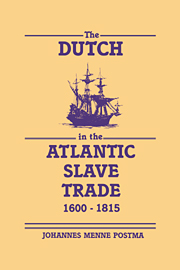Book contents
- Frontmatter
- Contents
- List of tables, figures, and maps
- Preface
- 1 Foundations of the slave traffic, 1600–61
- 2 Curaçao and the asiento trade, 1650–1730
- 3 The Dutch on the West African coast
- 4 Trade and politics on the African coast
- 5 Volume of African exports and origins of slaves
- 6 Organization and mechanics of the trade
- 7 The triangular trade
- 8 The Dutch plantation colonies under WIC monopoly, 1618–1738
- 9 The era of the free trade, 1730–80
- 10 The slaves: their treatment and mortality
- 11 Finances, marketing, and profitability
- 12 The end of the Dutch slave trade, 1781–1815
- Appendixes
- Bibliography
- Index
- Frontmatter
- Contents
- List of tables, figures, and maps
- Preface
- 1 Foundations of the slave traffic, 1600–61
- 2 Curaçao and the asiento trade, 1650–1730
- 3 The Dutch on the West African coast
- 4 Trade and politics on the African coast
- 5 Volume of African exports and origins of slaves
- 6 Organization and mechanics of the trade
- 7 The triangular trade
- 8 The Dutch plantation colonies under WIC monopoly, 1618–1738
- 9 The era of the free trade, 1730–80
- 10 The slaves: their treatment and mortality
- 11 Finances, marketing, and profitability
- 12 The end of the Dutch slave trade, 1781–1815
- Appendixes
- Bibliography
- Index
Summary
Since 1958, when as a student I crossed the Atlantic from Rotterdam to New York on a passenger ship, I have been intrigued by the massive movement of people across that ocean. As a graduate student during the 1960s I developed an interest in African history. Coupled with my Dutch background and my decision to stay in America, it is no surprise that all of this converged into a strong interest in transatlantic migrations. The Dutch involvement in the Atlantic slave trade had received only scant attention up to then, and I decided to fill this gap by writing a doctoral dissertation on the Dutch participation in that forced migration from Africa. After completing a dissertation for Michigan State University in 1970, and publishing a number of articles in scholarly journals, this book is the culmination of many years of research that should place the Dutch role in the Atlantic slave trade in proper perspective.
The Dutch involvement in the Atlantic slave trade is a subject of enormous complexity. Not only does it cover about two centuries of history, but it has wide-ranging geographical dimensions, including Europe, Africa, North America, South America, and the Caribbean. In addition, the subject involves complicated economic, demographic, medical, and statistical dimensions.
Organizing this rather complex subject into a readable book has not been an easy task, and it has necessitated a number of revisions. Chronological, geographic, and thematic developments have all been employed to provide a structure for this book.
- Type
- Chapter
- Information
- The Dutch in the Atlantic Slave Trade, 1600–1815 , pp. xi - xivPublisher: Cambridge University PressPrint publication year: 1990

